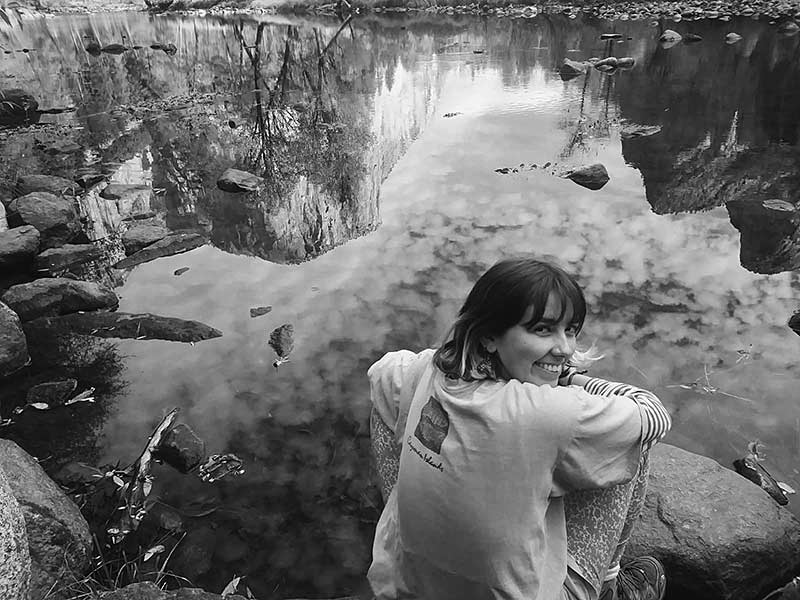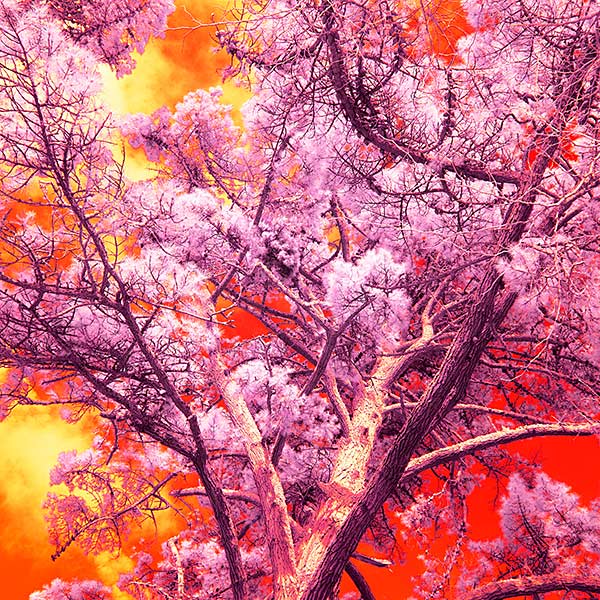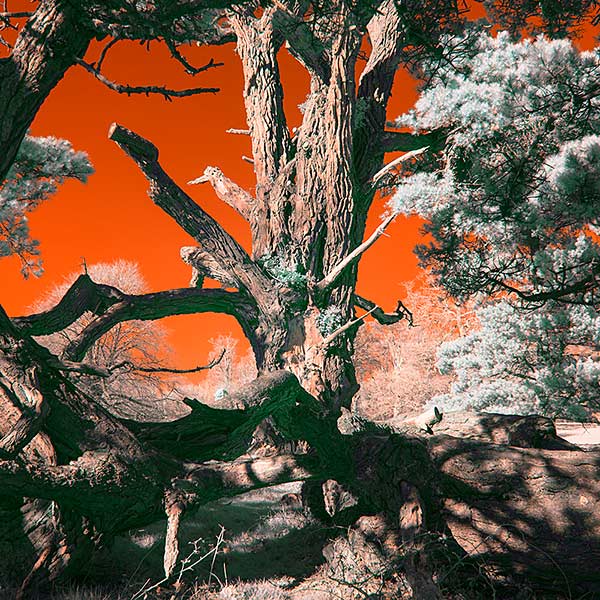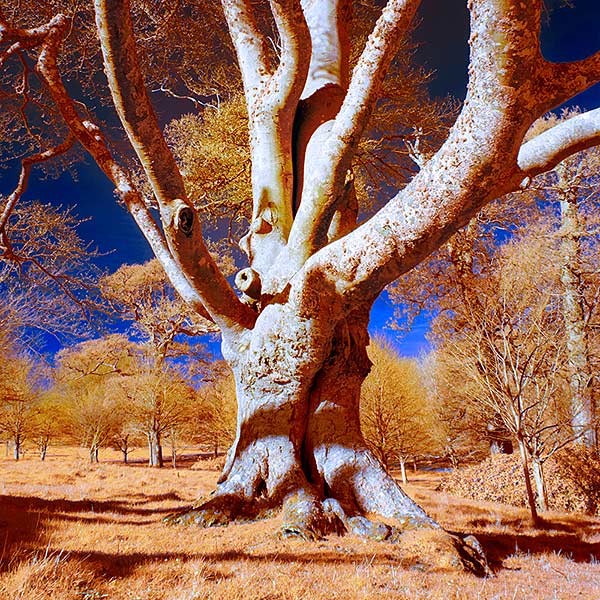
Grace Finnie
Grace’s work is eye catching and unexpected. Her subject matter transforms through a unique process that comes from her strong working knowledge of film photography.
Buy ‘Beech Tree’ by Grace Finnie in the Sample Store.
My name is Grace and I’m a natural history visual artist and infrared photographer, currently living in Cornwall. I have a keen eye for the abstract, which has naturally weaved its way into my creative practice alongside a love for the natural world. I aim to shed new light on our depleting old growth forests and remaining ancient trees, through a growing portfolio of alternative portraits of Britain’s older special specimens.
-Infrared photography isn’t something you see everyday. What drew you to this unique medium and why does it interest you?
The first time I saw an infrared photograph was when I discovered artist Richard Mosse – his incredibly bold series ‘Infra’ and ‘Enclave’, depicting conflict in the Congo, blew me away! I think my keen eye for colour was mesmerized by the surreal possibilities this medium has . The idea that infrared and full spectrum photography reveals hidden wavelengths, is so much more than the abstract colour palette; I feel it has the potential to bring abstract topics into fruition too. It has the power to shed light on issues that are important but may be hidden from everyday consciousness, or facts that aren’t known can become the forefront of conversation.
I know you are inspired by nature, and trees feature often as your subject matter. What draws you to nature scenes what about them do you find inspirational?

As cliche as it is to say, I have loved nature and being amongst it for my whole life, but I think as I’ve grown up (a bit at least!) I can appreciate how sacred the natural world is – particularly wild places. Finding inspiration from these scenes is not hard. What I love is that sheer sense of awe and wonder you get from being in the presence of a gnarly ancient Beech tree; it both humbles me and makes me feel miniscule. All mundane troubles seem to disappear rather quickly too, when you’re gawking at buzzards gliding and swooping up in the sky.Trees are my main subject focus because I want to highlight their magical spirit. I also work in the woods helping to sustainably manage ancient broadleaf trees, I can’t get enough of them!
– Can you tell us a bit about your process and equipment (camera, etc)?
I’ve converted my Sony into a full-spectrum camera to take my images. Essentially this means that the glass plate in front of the sensor in most digital cameras has been removed, so that a wider range of light wavelengths can hit the sensor. To narrow my spectrum to infrared, I use a filter on the lens which results in only those wavelengths being detected and captured. This creates a pretty whacky raw image, with a white balance that shocks photoshop a little. Imagine bright oranges with purples and pinks, no black or white. I sometimes leave the images raw, but tend to fiddle with the exposure and white balance to produce a calmer backdrop to then edit the colour to how I want.
– The colour in your work is pretty unexpected. Do you have an idea of what colours will manifest themselves in the final product, or is it always a surprise?
So I know that healthy foliage will manifest into a more successful image, as the chlorophyll in the leaves absorbs infrared thus appearing bright and ‘colourful’ in the photos. In that sense I have an idea of what will be the more vibrant, pigmented parts of the image and is partly why I’ve chosen this medium to document trees and plants – because it works so well with their natural material. The range of false colour in my work is due to creative manipulation in post-production; I adjust the hue of the image depending on what I feel best ‘suits’ the tree or landscape.

‘Pinus Radiata’

‘Cedris Libani’
– Which artists, either current or historical, inspire you most?
As my style and creative processes are constantly changing and developing, I tend to draw inspiration from many things thus I have accumulated a variety of artistic influences from Maggi Hambling and Emily Carr to Wes Anderson and Mary Oliver. Beth Moon is a legendary woman who I would say is one of my biggest inspirations; she has travelled the world photographing the most beautiful ancient trees, under the most beautiful starry skies and produces incredible black and white sacred images. There’s a great infrared photographer Bradley G Munkowitz, whose psychedelic visuals I really admire and probably magpie to my own work. I also really love the work by The Marshmallow Laser Feast My source of emotional influence has come from the teachings of photo artist Sandra Semchuk, who I was lucky enough to be taught by whilst studying in Canada in 2018. Her work focuses a lot on dialogue and trust, and the importance of photographic art as a collaboration piece with the viewer. This wonderfully wild and intelligent lady has a deep rooted connection and respect for the natural land, which is unparalleled to anyone I’ve ever met. She’s a fellow tree-hugger who I truly admire and am thankful to, for encouraging a love for the wilderness in and around us.

‘Fagus Sylvatica’ – Beech Tree T shirt available for purchase.
Your writing is interesting and poetic. Is writing itself something that interests you or do you just use it as a tool to offer insight into your work?
Thank you yeah I’ve found myself dabbling in poetry recently, and more so since Covid-19 lockdown. It’s a romantic way to reflect and engage with everything around you! The written word goes hand-in-hand with art and, probably more so, photography which is great because everybody reacts to and engages with things in different ways. Art has the power to transcend language and make scientific fact more accessible, as it taps into people’s emotions more than numbers and figures do. Writing could be seen as art’s back up. But then again writing, in all its forms, can also be considered art. I guess I do use my writing as a means of explaining or giving context to the topics in my photos that interest me. I often like to be creative with this written information.

